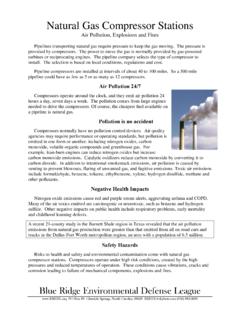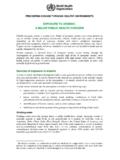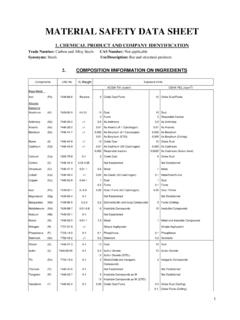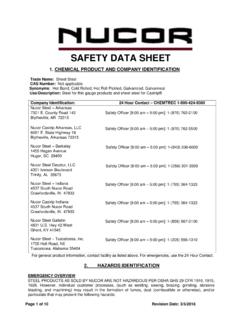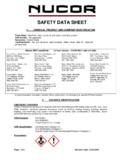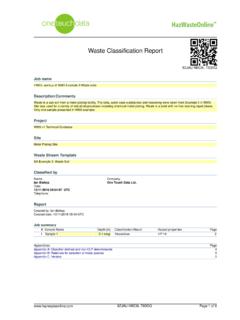Transcription of FACT SHEET asphalt plants - BREDL
1 BLUE RIDGE ENVIRONMENTAL DEFENSE BOX 88 Glendale Springs, North Carolina 982-2691 office (336) 977-0852 cellASPHALT PLANTSCONTAMINANTS OF CONCERN:An overview of7toxicsubstancesreleasedfromasphaltpro cessingfacilitiesand their known effects on human healthAsphalt plants aresources of air pollutionthat may emitsignificantlevels of both particulatematter and gaseous volatile organic compounds (VOCs). These pollutants are considered to bedangerousto human VOCs arealsosuspected carcinogensor cancer-causingagents( fact SHEET : Information Regarding asphalt Concrete plants ,number 5, November1996,Ohio EPA, Division of Air Pollution Control Small Business Assistance Program).No two asphalts are chemically chemical makeupof asphaltdepends on the chemicalcontent of the original crude petroleum from which it is made. Othermanufacturing methodswhich alter the chemical makeup of asphaltincludeasphalt cementadditives, higher operatingtemperatures,and theuse of recycled asphalt paving cause increases in toxic emissions(Letterto Dr.)
2 Ernest Fuller, Division of Air Quality, Raleigh Regional Office, from Louis Zeller, BREDL ,re: Tar Heel Paving DRAFT permit #08977R00, March 12, 2001).The following are examples ofsevenpollutantstypicallyfoundat various levelsin emissionsfrom asphalt plants -hydrogen sulfide, benzene, chromium, formaldehyde, polycyclic aromatichydrocarbons (PAHS), cadmium and arsenic and the known effects of these substances onhuman health:Hydrogen sulfide(H2S). Hydrogen sulfideis a poisonous, colorless gas that is associatedwith the characteristic smell of rotten to be a problem in communitieslocated near certain types of industrial sites thatreleasehydrogen sulfide. People who live nearan industrial facility that emits hydrogen sulfide may be exposed to higher levels tohydrogen sulfideoccurs frombreathing contaminated air or drinkingcontaminated sulfide remains in the air for about which it changesinto sulfur dioxide and sulfuric acid.
3 Hydrogen sulfide may also be released as a liquid wastefrom an industrial facility. It is not known whether children are more sensitive to hydrogen sulfidethan adults nor is it known if hydrogen sulfide causes birth defects (ToxFAQs for HydrogenSulfide,Agency for Toxic Substances and Disease Registry, July 2006, CAS #7783-06-04.)Exposures to high concentrations of hydrogen sulfide may result in respiratory distress,pulmonary edema, nervous system depression,neurobehavioral effects,tissue hypoxia,cardiovascular effects,unconsciousnessand to lower concentrations ofhydrogen sulfide can result in less severe neurological and respiratory effects such asincoordination, loss of smell, nasal symptoms, sore throat, cough,and evidencesuggests thatpeople withasthma maybe overlysensitiveto hydrogen sulfide, and impairedfunction has been observed inpeople withasthmawho were exposed to low levels exposure study found anincreased prevalence of eye irritations in residentsexposed tolow levels ofhydrogen case reports suggestthat high exposurestorespiratory arrest and pulmonary edema canoccur after a brief exposure tohydrogen people recoverafter exposureto hydrogen sulfidemany individuals reportpermanentor persistent neurological effects including headache, poor concentration ability andattention span, impaired short memory and motor function(Toxicological Profile for HydrogenSulfide, US Department of Health and Human Services, Agency for Toxic Substances andDisease Registry,2006).
4 , also known as benzol, is a colorless liquid with a sweet isa known carcinogen or enters the body throughthelungs,gastrointestinal tract, and acrosstheskin. Brief exposure (5-10 minutes) to very high levels ofbenzene in air can result in death. Lower levelsof exposurecan cause drowsiness, dizziness,rapid heart rate, headaches, tremors, confusion, and unconsciousness. Continuous exposure tobenzene can lead to anemiaandexcessive bleeding,andmay beharmful to the immunesystembyincreasing the chance for infection and perhaps lowering the body's defense to benzene has been associated with development of a particular type of leukemiacalled acute myeloid leukemia (AML). The Department of Health and Human Services, theInternational Agency for Cancer Research and the EPAhasdetermined that to benzene may be harmful tohumanreproductive can pass fromthe mother's blood to a fetus, but it is not known what effects exposure to benzene might haveon the developing fetus in pregnant women or on fertility in , studies withpregnant animals show that breathing benzene has harmful effects on the developing effects include low birth weight, delayed bone formation, and bone marrow can be affected by benzene exposure in the same ways as adults, andisnot known ifchildren are more susceptible to benzene poisoning than adults(Public Health Statement forBenzene,Draft for Public Comment,Agency for Toxic Substances and Disease Registry,September 2005,CAS#: 71-43-2).
5 Is a naturallyoccurring element found in rocks, animals, plants , soil,and in volcanic dust and cannot be tasted and has no ispresent in the environment in several different forms. The most common forms arechromium(0), chromium(III), and chromium(VI), also known as hexavalent (VI) and chromium(0) areusuallyproduced by industrial highlevels of chromium(VI) can cause irritation to the nose, such as runny nose, nosebleeds, andulcers and holes in the nasal (VI) at high levels can damage the nose andcan cause large amounts of chromium(VI) can cause stomach upsets andulcers, convulsions, kidney and liver damage, and even contact with certainchromium(VI)compounds can cause skin ulcers. Some people are extremely sensitive tochromium(VI) or chromium(III). Allergic reactions consisting of severe redness and swelling ofthe skin have been noted(ToxFAQs for Chromium,Agency for Toxic Substances and DiseaseRegistry,February 2001,CAS#:7440-47-3).
6 Is a nearly colorless gas with a pungent, irritating odor evenat very low concentrations (below 1 ppm).Formaldehyde is a potent sensitizer and a probablehuman carcinogenor cancer-causing agent. Formaldehydeis an eye, skin, and respiratory tractirritant;inhalation of vapors can produce narrowing of the bronchiandaccumulation of fluid inthe may be more susceptible than adults to the respiratory effects of formaldehyde. Evenfairly low concentrations of formaldehyde can produce rapid onset of nose and throat irritation,causing cough, chest pain, shortness of breath, and wheezing. Higher exposures can causesignificant inflammation of the lower respiratory tract, resulting in swelling of the throat,inflammation of the windpipe and bronchi, narrowing of the bronchi, inflammation of the lungs,and accumulation of fluid in the lungs(Medical Management Guidelines for Formaldehyde,Agency for Toxic Substances and DiseaseRegistry,CAS#: 50-00-0, updated 11/02/06).
7 Polycyclic aromatic hydrocarbons(PAHS).Polycyclic aromatic hydrocarbons(PAHs) are a group of over 100 different chemicals that are formed during the incompleteburning of coal, oil and gas, garbage, or other organic substances and found in coal tar, crudeoil, creosote, and roofing tar. The Department of Health and Human Services has determinedthat some PAHs may reasonably be expected tocause people who havebreathed or touched mixtures of PAHs and other chemicals for long periods of time havedeveloped have caused cancer in laboratory animals when they breathed air containingthem (lung cancer), ingested them in food (stomach cancer) or had them applied to their skin(skin cancer).PAHsare found in airattached to dust particles, and can enter water throughdischarges can enter waterfrom industrial and wastewater treatment plantswhere they canmove through soil to contaminate contents of plants andanimals may bemuch higher than PAH contents of soil or water in which they live(ToxFAQs for PolycyclicAromatic Hydrocarbons (PAHs),Agency for Toxic Substances and Disease Registry,September 1996).
8 Is an element that occurs naturallyin the earth's cadmiumis a soft, silver-white metalthat attaches to small particles in the who live nearhazardous waste sites or factories that release cadmium into the air have the potential forexposure to cadmium in air with very high levels of cadmium can severely damage the lungs and may air with lower levels of cadmium over long periods of time (for years) mayresult kidney disease, lung damage and fragile on human exposure to cadmium islimited, but studies show that rats that breathed in cadmium developed lung cancer, liverdamage and changes in the immune system. Female rats and mice that breathed high levels ofcadmium had fewer litters, babieswith morebirth defectsthan usual,reduced body weight,babies born withbehavioral problemsand learning a conservative approach, and based on the limited human data and the studies in rats, theUnited States Department of Health and Human Services (DHHS) has determined thatcadmium and cadmium compounds may reasonably be anticipated to be Agency for Research on Cancer (IARC) has determined that cadmium iscarcinogenic to EPA has determined that cadmium is a probablehumancarcinogen by inhalation(Public Health Statement for Cadmium,Agency for Toxic Substancesand Disease Registry,July, 1999, CAS # 1306-19-0).
9 Occurs naturally in soil and minerals and it therefore may enter the air,water, and landfrom wind-blown dust and may get into water from runoff and leaching. Arsenicreleased from power plants and other combustion processes is usually attached to very smalldustparticles. Thesedustparticles settle to the ground or are washed out of the airby attached todustmay stay in the air for many days and travel long distances. Ultimately,most arsenic ends up in the soil or sediment. Children may also be exposed to arsenic by eatingdirt, skin contact with soil or water that containsarsenic, or through inhalation. If you breathe airthat contains arsenic dust,particlesof arsenic -contaminated dust maysettle onto the lining ofthe arsenic is usually found in the environment combined with other elements such asoxygen, chlorine, and sulfur.
10 arsenic combined with carbon and hydrogen is referred to asorganic oral exposure to inorganic arseniccan results in apattern of skinchangescalled"corns" or "warts" on the palms, soles, and torsothat may develop into arsenic has also been reported to increase the risk of cancer in the liver,bladder, kidneys, prostate, and lungs. The Department of Health and Human Services (DHHS)has determined that inorganic arsenic is known International Agency forResearch on Cancer (IARC) has determined that inorganic arsenic is carcinogenic to also has classified inorganic arsenic as a known human levels of inorganic arsenicwill result ina sore throat,irritated lungsand thepotential to developlung cancer. This has been seen mostly in workers exposed to arsenic atsmelters, mines, and chemical factories, but also in residents living near smelters and chemicalfactories.
